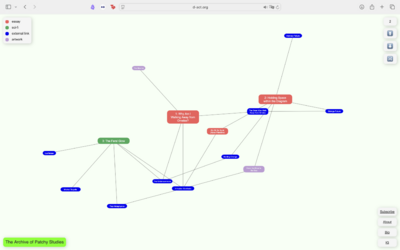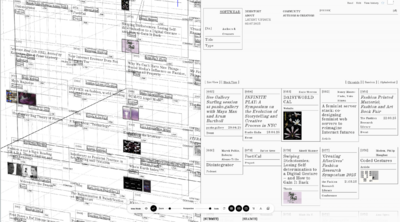Interface
From softwear.directory
Jump to navigation
Jump to search
⤢ a directory that gathers, stacks and links practices that work with, through and beyond (digital) fashion […]
LATEST UPDATE 26.09.2025
[088]
The Archive Of Patchy Studies
Individual
critical

Archive Of Patchy Studies (screenshot) by Noam Youngrak Son
Archive of Patchy Studies is a living, diagrammatic platform by Noam Youngrak Son that maps knowledge through a rhizomatic, non-extractive interface. Designed as a motherboard of interconnected nodes-ranging from essays and images to links and notes-it visualizes conceptual, aesthetic, and affective relations without relying on rigid taxonomy. The archive grows organically, shaped by conversation, intuition, and resistance to capitalist tempo.
Rather than simply storing information, it proposes an alternative infrastructure: one where artistic labor circulates relationally and ethically, inviting slower, situated forms of engagement and meaning-making over time. Some content remains open; other nodes are accessible via subscription.
Diagrams, especially interactive, rhizomatic ones like Son's 'rhizomatic motherboard', challenge traditional data visualisation norms by turning static charts into dynamic, interconnected maps. Unlike dashboards or classification-driven graphs, these diagrams emphasise emergence, fuzziness and mutual causality. Treating the connecting nodes as active elements rather than fixed data points emphasises the importance of non-hierarchical, networked representations, and illustrates how diagrams can become lively and inclusive infrastructures.
“Over time, I hope this platform becomes not just an accumulation of information, but a transformative infrastructure: a space where artistic labor is not extracted, but comes to obtain other forms of value mutually.”
29.12.25
[090]
Vanish Pointer
Individual
experimental

Vanish Pointer by Hyunseo Cho (as used on the Softwear Directory)
Vanish Pointer is a web-based project by Hyunseo Cho that reimagines the digital interface as a three-dimensional, perspective-based space. Designed as both a web extension and a standalone platform, this tool establishes an analogy between our perception of web interfaces and the visual system of perspective. Users can shift the vanishing point to explore websites from new angles, transforming flat webpages into dynamic spatial environments where citational elements — such as sources, authors, dates and internal references — become central structuring forces. Users can invert hierarchies, reveal hidden relationships, and explore multidimensional connections by changing their viewpoint — including curvilinear, panoramic, and spherical perspectives. Vanish Pointer thus encourages critical and sensory engagement with the knowledge architectures that shape online content.
In an age where information circulates endlessly, is remixed and is decontextualised, developing visual citation methods is not just a matter of giving credit; it is an urgent way of taking relational accountability. The hypertextual nature of our digital environments is full of hidden lineages: sources, references and contextual cues that are often obscured by flat, linear design conventions. Experimental approaches such as Vanish Pointer reclaim these overlooked dimensions, rendering citation as a spatial, visual and navigable architecture, not just metadata. By reimagining interfaces as relational terrains, such tools encourage users to think critically about how knowledge is structured, traced and performed, transforming acts of reading, browsing and linking into moments of situated awareness.
In doing so, they foreground citational relationality — an understanding of citation as an active, situated practice that reveals the networks of dependency, influence and care underpinning digital knowledge, rather than as a static reference.
29.12.25
[SUBMIT]
As the online realm often feels infinite, this directory highlights non-commercial, critical, and experimental online content related (but not limited) to fashion and creative practices. It features projects, essays, visuals, and events, offering tools to navigate this dynamic landscape.
In gathering a wide variety of practitioners and collectives, we are always expanding, and looking to add to this growing bibliography of ‘being online’.
If you've encountered or created something that fits within this scope, feel free to share and submit!
Retrieved from "https://softwear.directory/index.php?title=Interface&oldid=3734"